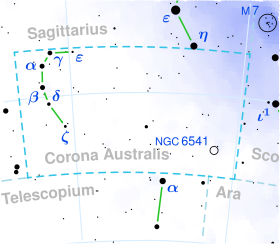Astronomy:Beta Coronae Australis
| Observation data Epoch J2000.0 Equinox (celestial coordinates) | |
|---|---|
| Constellation | Corona Australis |
| Right ascension | 19h 10m 01.75580s[1] |
| Declination | −39° 20′ 26.8644″[1] |
| Apparent magnitude (V) | 4.10±0.01[2] |
| Characteristics | |
| Spectral type | K0 II/III CN1.5[3] |
| U−B color index | +1.07[4] |
| B−V color index | +1.20[4] |
| R−I color index | +0.61[4] |
| Astrometry | |
| Radial velocity (Rv) | 2.7±0.7[5] km/s |
| Proper motion (μ) | RA: +4.37[1] mas/yr Dec.: −36.65[1] mas/yr |
| Parallax (π) | 6.88 ± 0.25[1] mas |
| Distance | 470 ± 20 ly (145 ± 5 pc) |
| Absolute magnitude (MV) | −1.71[6] |
| Details | |
| Mass | 5.17±0.26[7] M☉ |
| Radius | 38.5±1.9[8] R☉ |
| Luminosity | 614±33[9] L☉ |
| Surface gravity (log g) | 1.26[10] cgs |
| Temperature | 4,575±55[11] K |
| Metallicity [Fe/H] | +0.24[10] dex |
| Rotational velocity (v sin i) | 6.2±2[12] km/s |
| Other designations | |
| Database references | |
| SIMBAD | data |
Beta Coronae Australis (Beta CrA), Latinized from β Coronae Australis, is a solitary star[14] located in the southern constellation Corona Australis. It is visible to the naked eye as a faint, orange-hued star with an apparent visual magnitude of 4.10.[2] The star is located around 470 light years distant from the Sun based on parallax,[1] and is drifting further away with a radial velocity of 2.7 km/s.[5] At its current distance, Beta CrA's brightness is diminished by 0.29 magnitudes due to interstellar dust.[15]
Beta CrA has a stellar classification of K0 II/III CN1.5,[3] indicating that it is an evolved K-type star with the blended luminosity class of a bright giant and a regular giant star. The suffix CN1.5 indicates that the object has an anamolous overabundance of cyano radicals in its spectrum, making it a CN star. Having exhausted the supply of hydrogen at its core, the star has expanded to 39 times the Sun's girth.[9] It has 5.17 times the mass of the Sun shines with a luminosity 614 times that of the Sun[9] from its photosphere at a surface temperature of 4,575 K.[11] Beta CrA is metal enriched (174% solar iron abundance[10]) and spins modestly with a projected rotational velocity of 6.2 km/s.[12]
References
- ↑ 1.0 1.1 1.2 1.3 1.4 Template:Cite New HIP red.
- ↑ 2.0 2.1 Høg, E.; Fabricius, C.; Makarov, V. V.; Urban, S.; Corbin, T.; Wycoff, G.; Bastian, U.; Schwekendiek, P. et al. (March 2000). "The Tycho-2 catalogue of the 2.5 million brightest stars". Astronomy and Astrophysics 355: L27–L30. ISSN 0004-6361. Bibcode: 2000A&A...355L..27H.
- ↑ 3.0 3.1 Houk, N. (1982). Michigan Catalogue of Two-dimensional Spectral Types for the HD stars. Volume III: Declinations −40° to −26°. Bibcode: 1982mcts.book.....H.
- ↑ 4.0 4.1 4.2 Johnson, H. L.; Mitchell, R. I.; Iriarte, B.; Wisniewski, W. Z. (1966). "UBVRIJKL Photometry of the Bright Stars". Communications of the Lunar and Planetary Laboratory 4: 99–110. Bibcode: 1966CoLPL...4...99J.
- ↑ 5.0 5.1 Gontcharov, G. A. (November 2006). "Pulkovo Compilation of Radial Velocities for 35 495 Hipparcos stars in a common system". Astronomy Letters 32 (11): 759–771. doi:10.1134/S1063773706110065. ISSN 1063-7737. Bibcode: 2006AstL...32..759G.
- ↑ Anderson, E.; Francis, Ch. (May 2012). "XHIP: An extended hipparcos compilation". Astronomy Letters 38 (5): 331–346. doi:10.1134/S1063773712050015. ISSN 1063-7737. Bibcode: 2012AstL...38..331A.
- ↑ Kervella, Pierre; Arenou, Frédéric; Thévenin, Frédéric (2022). "Stellar and substellar companions from Gaia EDR3". Astronomy & Astrophysics 657: A7. doi:10.1051/0004-6361/202142146. ISSN 0004-6361. Bibcode: 2022A&A...657A...7K.
- ↑ Kervella, P.; Thévenin, F.; Di Folco, E.; Ségransan, D. (October 2004). "The angular sizes of dwarf stars and subgiants". Astronomy & Astrophysics 426 (1): 297–307. doi:10.1051/0004-6361:20035930. ISSN 0004-6361. Bibcode: 2004A&A...426..297K.
- ↑ 9.0 9.1 9.2 Brown, A. G. A. (August 2018). "Gaia Data Release 2: Summary of the contents and survey properties". Astronomy & Astrophysics 616: A1. doi:10.1051/0004-6361/201833051. Bibcode: 2018A&A...616A...1G. Gaia DR2 record for this source at VizieR.
- ↑ 10.0 10.1 10.2 Anders, F. et al. (August 2019). "Photo-astrometric distances, extinctions, and astrophysical parameters for Gaia DR2 stars brighter than G = 18". Astronomy & Astrophysics 628: A94. doi:10.1051/0004-6361/201935765. ISSN 0004-6361. Bibcode: 2019A&A...628A..94A.
- ↑ 11.0 11.1 Blackwell, D. E.; Lynas-Gray, A. E. (May 1998). "Determination of the temperatures of selected ISO flux calibration stars using the Infrared Flux Method". Astronomy and Astrophysics Supplement Series 129 (3): 505–515. doi:10.1051/aas:1998202. ISSN 0365-0138. Bibcode: 1998A&AS..129..505B.
- ↑ 12.0 12.1 De Medeiros, J. R.; Alves, S.; Udry, S.; Andersen, J.; Nordström, B.; Mayor, M. (January 2014). "A catalog of rotational and radial velocities for evolved stars". Astronomy & Astrophysics 561: A126. doi:10.1051/0004-6361/201220762. ISSN 0004-6361. Bibcode: 2014A&A...561A.126D.
- ↑ * bet CrA -- Star, database entry, SIMBAD. Accessed on line September 5, 2008.
- ↑ Eggleton, P. P.; Tokovinin, A. A. (11 September 2008). "A catalogue of multiplicity among bright stellar systems". Monthly Notices of the Royal Astronomical Society 389 (2): 869–879. doi:10.1111/j.1365-2966.2008.13596.x. ISSN 0035-8711. Bibcode: 2008MNRAS.389..869E.
- ↑ Gontcharov, George A.; Mosenkov, Aleksandr V. (28 September 2017). "Verifying reddening and extinction for Gaia DR1 TGAS main sequence stars". Monthly Notices of the Royal Astronomical Society 472 (4): 3805–3820. doi:10.1093/mnras/stx2219. ISSN 0035-8711. Bibcode: 2017MNRAS.472.3805G.
<ref> tag with name "Gould1879" defined in <references> is not used in prior text.
 |


